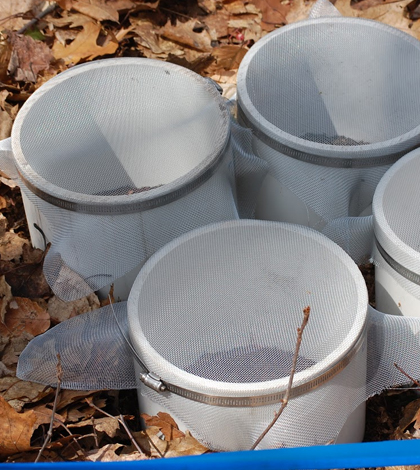Healthy, Diverse Soil Invertebrate Communities Mitigate Impacts Of Climate Change

In each soil plot, the researchers inserted four chambers and altered the soil community to a different extent.(Credit Dr Serita Frey / University of New Hampshire)
You don’t have to look far to find one of the Earth’s biggest contributors of atmospheric carbon — just scoop up a handful of dirt. Microbes living in the soil release 10 times more carbon into the atmosphere than humans worldwide. This doesn’t let humans off the hook, however, as anthropogenic activity can drastically impact the rate of this emission.
New research from the Yale School of Forestry and Environmental Studies reveals that healthy and diverse soil communities can mitigate the feedback effect that occurs between climate change and soil respiration. A paper detailing the findings was published online in the Proceedings of the National Academy of Sciences.
Yale postdoctoral fellow Thomas Crowther led the study as part of the Harvard Forest Long-Term Climate Change Study. Using the Harvard Forest natural laboratory, Crowther and a team of researchers manipulated soil communities within four isolated chambers at various plots in the forest, replicating human disturbance and removing invertebrates and important microbes to varying degrees within each chamber.
While the Harvard Forest experiment has been ongoing for eight years, with nitrogen continuously added to the area’s soil to emulate projected climate change, the preparation for this particular study began in 2013. The researchers established the study plots over a few weeks in the fall, when decaying foliage boosts microbial activity and soil respiration. Some plots were artificially warmed from below to simulate warmer climates. Over the next several months, the researchers let the sites function on their own, then returned to measure decomposition and determine respiration rates. After two years of repeating this process, the researchers came to a surprising conclusion.

Underground warming replicates the predicted effects of climate change over the next 100 years in the Harvard Forest Long-Term Climate Change Study. (Credit Dr Serita Frey / University of New Hampshire)
“In the soils where we removed the invertebrates, or replicated human disturbance, climate change had a really strong impact,” Crowther said, noting that in the most extreme sites, respiration rates had doubled. “But under normal conditions, there was no impact from climate change. Total mitigation.
“We were really surprised by the magnitude of the effect,” he said.
As ambient temperature increases, so too does soil respiration. This feedback effect has been understood for a “very long time,” Crowther said, and is regarded as one of the biggest anthropogenic contributors to further climate change. But previous research had failed to identify just how much human disturbance could increase respiration rate — or that soil invertebrates could mitigate so much of that feedback.
Invertebrates such as isopods (known commonly as roly polys) and millipedes reduce the impact of climate change by consuming the microbes responsible for greenhouse gas emissions. Another well-known dirt dweller, the earthworm, didn’t prove to have much of an effect on respiration rates.
Crowther said he hopes to continue the research on a broader scale, studying if the feedback effect is more or less governed by invertebrate communities in different parts of the world. Such a study could produce a map showing which regions warrant the greatest ecological concern.
“I’d like to make sure the message is clear,” Crowther said. “The more we damage soil and invertebrate communities around the world, the greater these impacts are going to be.”
Top image: In each soil plot, the researchers inserted four chambers and altered the soil community to a different extent.(Credit Dr Serita Frey / University of New Hampshire)




0 comments